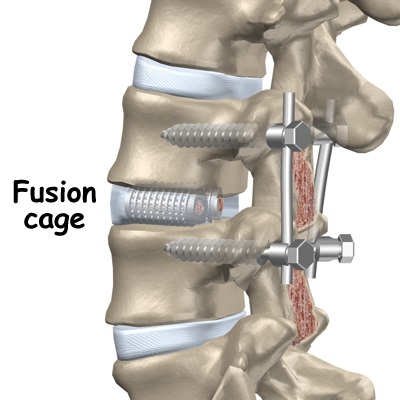Degenerative joints, the joints that wear out over time, can cause severe pain and may require
surgical procedures to make things more manageable. One of the most common procedures to reduce pain in degenerative joints in your spine is called spinal fusion. The procedure involves fusing two joints together in a way that two bones grow into one bone. How spinal fusion is performed? How can you accelerate spinal fusion recovery? Keep reading to find your answers.
What Is Spinal Fusion?
The surgery connects two or more vertebrae in the spine permanently, so the motion between them is eliminated. Your surgeon, using the natural healing process of the bones, places a  bone-like material within the space between your two joints or vertebrae in your spine. Then metal screws, plats and rods are used to keep your vertebrae together and make them into one solid unit. However, it also affects the way your spine moves and exerts more pressure on the vertebrae directly below and above the fused portion, which may lead to more spinal degeneration in these areas. It is, therefore, important to understand the important changes you have to make to your lifestyle, so you can lead a healthy life.
bone-like material within the space between your two joints or vertebrae in your spine. Then metal screws, plats and rods are used to keep your vertebrae together and make them into one solid unit. However, it also affects the way your spine moves and exerts more pressure on the vertebrae directly below and above the fused portion, which may lead to more spinal degeneration in these areas. It is, therefore, important to understand the important changes you have to make to your lifestyle, so you can lead a healthy life.
How to Speed Up Spinal Fusion Recovery
Spinal fusion recovery may take anywhere between 3 and 6 months. During this time, you will have to undergo certain types of physical therapy sessions to trigger recovery. Here's a recovery plan that will help you start your normal life as quickly as possible.
Day 1 – Day 2
- Pain medication: You will need pain medication immediately after the procedure. Your doctor will give you the medication via the vein or the muscle of the leg or arm. You will have to take oral medication once the pain becomes more manageable.
- Tests: Your doctor will order blood tests periodically to monitor hemoglobin. This helps confirm that blood oxygen levels aren't too low.
- Back brace: Your surgeon may ask you to wear a back brace during your surgery to limit the motion in the spine and accelerate spinal fusion recovery.
- Therapy and exercises: You will require occupational therapy, physical therapy and exercise soon after your surgery to regain strength and function. You may even have to spend a few days in a rehabilitation center to move and walk properly.
Day 3 – Day 6
- Medication: You may still experience pain after being discharged from hospital. Your doctor may prescribe narcotic to help relieve pain. If that's the case, avoid drinking alcohol and don't drive because the medication can cause impaired judgment.
- Ice packs: Using an icepack on the site of pain may help relieve it a bit. Be sure to ask your doctor if it's appropriate to apply the ice and how to get the best result.
- Be active: While it is not possible to return to your normal activities, but early after your surgery, you should still try to do some exercises, like walk slowly, after you get home. Increase other activities gradually. Ask your doctors about the activities you should avoid – they may not recommend bending and lifting objects if you've undergoing a lumbar spinal fusion.
1-4 Weeks
- Avoid infections: Just like with any other surgery, people with spinal fusion may develop infections. Though this occurs in 1% of the cases, it is still possible. You may develop a wound infection usually within the first 10 days of your surgery. Symptoms of infection include pain, fever higher than 101 degrees, redness at the incision site, and change in the appearance, amount or odor of drainage.
- Treat infection: Your doctor will prescribe antibiotics if an infection does develop. You may or may not require further surgery, but in some cases, it becomes important to remove the metal hardware inserted during the surgery. You may have to stop using narcotic pain medication, but you can take Tylenol for pain relief. Avoid taking aspiring products and NSAIDs because they hamper the growth of new bone cells.
1-3 Months
- Avoid certain movements: You still have to avoid certain movements such as twisting, bending and excess lifting for a few months following a procedure. Stress at the fused segments may lead to several complications.
- Wear a back brace: If you aren't using a back brace already, start using one for a betterspinal fusion recovery. You have to use it up to 3 months after your surgery.
- Resume normal activities: With 1-3 months after your surgery, you should gradually get back to your normal daily activities. You should take a break from work up to six months if your job includes physical activities.
Recovery After the Third Month
- Try a reconditioning program: After 3 months of your surgery, you should be in a reconditioning program to get in better shape. This will really help accelerate your spinal fusion recovery.
- Try aggressive exercise programs: It is natural for your abdominal muscles to weaken after your surgery, so you should now consider engaging in relatively more aggressive exercise programs. Be sure to work with a physical therapist to avoid doing any harm to the fused segments of your spine.
- Participate in a long-term exercise program: Your active participation in a self-directed exercise program will help accelerate healing. Your therapist may opt for a more specialized physical therapy to help you return to work.
